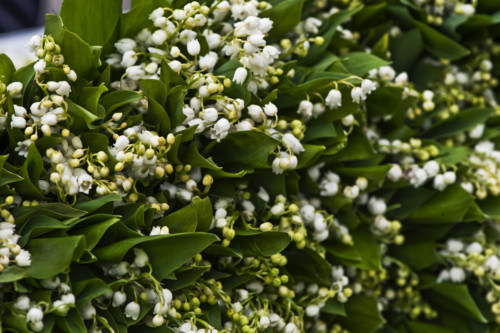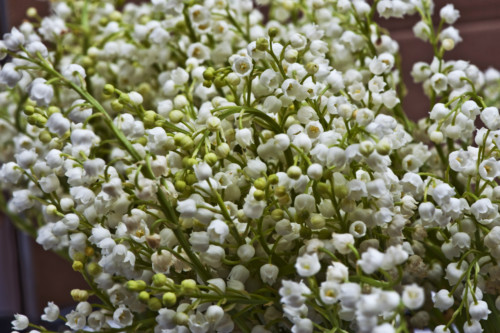
Letters From Paris: May 1st and the Politics of Flowers
Ever since I was a child in Paris’ Quartier Latin, I remember my parents bringing home Lily of the Valley spits on May 1st. Like most traditions, it had become a ritual. Early in the morning, someone, usually my father, would go to the bakery for the morning baguette and croissants. While this was happening he would walk around the block once, maybe even twice, to spot the most beautiful Lily of the Valley. At the time, it never occurred to me that this tradition was a purely French one. And I must admit I never even thought of getting into its history until Garden Collage asked me to write about it.
While preparing this piece, I even asked a few of my friends if they kept this tradition alive, what it meant to them and if they knew where it came from. Most of them told me it was about the celebration of Spring, as offering your loved ones Lily of the Valley meant luck for the year to come, though none of them– although my friends are all so admirably cultured– could tell me where the tradition came from. Let’s face it, nowadays, the “Premier Mai” (“First of May” in French, May Day in English) represents so many different things– most of them of high political meaning– that its initial meaning has been forgotten.
A Working Class Tradition
To most the 1st of May is International Labour Day. Which, of course, in France is celebrated by a public holiday– one of the many paradoxes my British friends here have a hard time understanding. By the end of the XIXth Century, workers’ unions started to gain more and more power. In fact, the first time the First of May was associated with union activism was in 1886, in the United States, when unions demanding the 8-hour workday paralyzed Chicago. Followed by 400,000 workers, the riots lasted four days and ended with the death of a dozen people, including seven policemen. Five anarchists were sentenced to death as a result of these events. Three years later, the International Socialist Congress met in Paris and declared May First the International Workers Day, in memory of the Chicago events. Marching every year, workers then wore a red triangle, a symbol of their three-point value system: 8 hours of work, 8 hours of sleep, 8 hours of leisure.
But in 1891, a barely-repressed riot in the North of France saw many workers killed, including a young woman wearing rose hip in her corsage. This was an homage to Fabre d’Eglantine (Eglantine means “rose hip” in French), creator of the Republican calendar during the French Revolution and first to associate the working masses with a national celebration. The symbol spread and became generally accepted as the French symbol of May 1st.
The Celtic Tradition
But, what about Lily of the Valley? Well, the roots of this tradition are much more ancient, as it seems the Celts always cherished the flower as a symbol of spring and the bountiful harvest. They even associated magical powers to the lovely Lily of the Valley, which they embraced as a token of good luck for the year to come. Beltaine, the Celtic Spring Fest that is celebrated on May 1st, was even one of the four grand celebrations of the Druidic religion, marking the passage from one year to another, from the dark seasons’ nocturnal slumber to daylight. A true celebration of yearly renewal, Spring Festivals embraced the passage from winter to summer both physically and spiritually. But even though it would be charming and convenient to draw a link between our modern-day custom and the ancient pagan ritual, the actual reason Lily of the Valley is still a gift of choice on May 1st is much more random.
A King’s Choice
In 1560, French King Charles IX, and his mother Catherine de Medicis were visiting a local Knight’s castle the South of France. The Knight, Louis de Girard de Maisonforte gives the king and his royal mother a bunch of Lilies of the Valley as a lucky charm. Enchanted by the attention and the flower, he took the tradition over the following year and gave each lady of his court a sprig and said: « May it be so every year .» And so was the long lasting tradition born. Later, the flower became the symbol of gallant encounters, being given by bachelors to their chosen one during the famous « Bals du Muguet » (Lily of the Valley balls). At the beginning of the century, fashion stylists would give their seamstresses three sprigs as a token of their appreciation for their hard work. Later, Christian Dior will even choose it as the emblem of his Couture House.
The XXth Century
In the quite unstable days France is currently going through, facing an unprecedented fight for its presidency between the far-right candidate Marine Le Pen, and the liberal Emmanuel Macron, let’s not forget how Lily of the Valley found its way back on the front of French first of May’s scene. As it is only in 1941, in the heart of World War II, that May 1st officially becomes a French national holiday, as its very own Labor Day. Head of the Vichy regime, Maréchal Pétain, true to his slogan « Travail. Famille. Patrie. » (Work, family, homeland), wanted to erase any trace of class conflict from the French society and unite workers and employers in a corporatist spirit. The pure and white Lily of the Valley was chosen to celebrate that day, in replacement for the far too communist and controversial red rose hip. Let’s also not forget that on May first the Front National (France’s very own far-right party founded by Marine Le Pen’s father) reunites to celebrate its nationalist icon, Joan of Arc. A date especially chosen in the late 1970s to gather forces and weight on the second round of the presidential elections, on May 8th.
Nowadays, a special derogation allows everyone to sell Lily of the Valley on that particular day. This year, I met a couple of South-Korean students, looking to make pocket money. Parents with their adorable kids focused on satisfying their customers. And the sweetest Romanian man, a car mechanic who had spent the week harvesting flowers wife to sell them on that one day. Let’s face it, more diversity and fraternity vibes were going on Monday in Saint-Germain des Prés than gentrified hipster ones. Let’s hope we can still celebrate our freedom the same way next year and not some corny, outdated, nationalist icon.




































